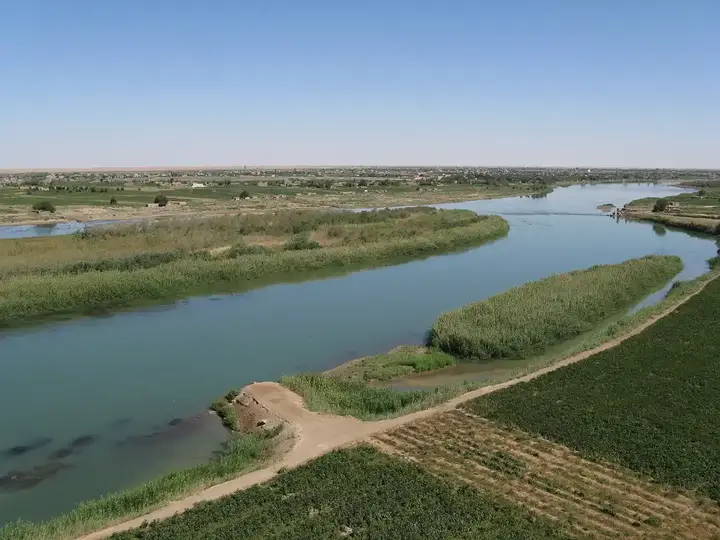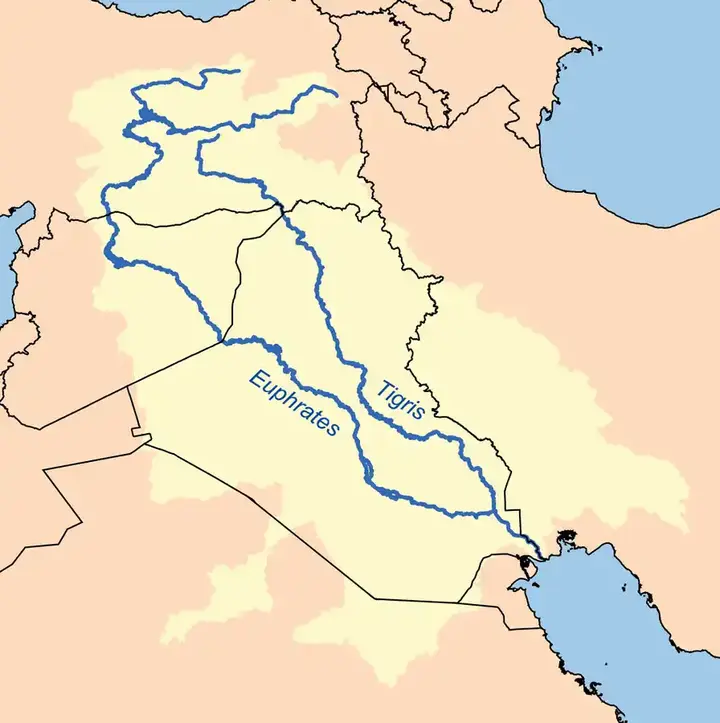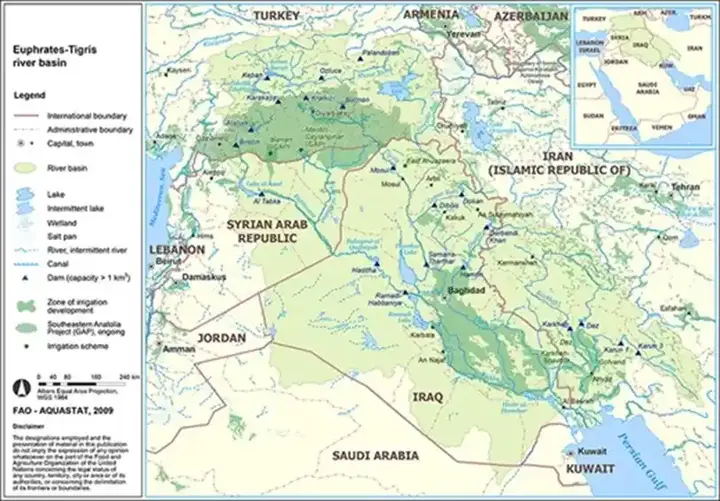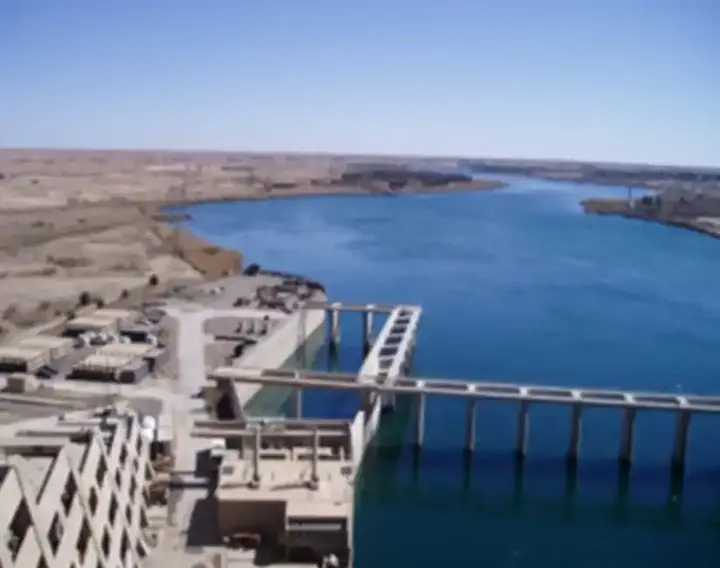Tigris and Euphrates: Lifelines in Mesopotamia
This article examines the importance of the Tigris and Euphrates river system, studying their origins, route and countries they cross, and their profound impact on the development of ancient civilizations, and on the free and future well-being of the peoples of the region.
Show key points
- The Tigris and Euphrates rivers, originating from the mountains of eastern Turkey, have historically nurtured the development of some of the world’s oldest civilizations in the Fertile Crescent.
- These two rivers traverse Turkey, Syria, and Iraq, forming a vast transboundary basin that sustains agriculture, supports human settlements, and generates electricity.
- With a combined flow length of about 4,850 kilometers, the Euphrates at around 3,000 kilometers is longer than the Tigris, which measures approximately 1,850 kilometers.
- ADVERTISEMENT
- Seasonal variations, dam constructions, and extensive irrigation practices significantly impact the flow rate and water quality of both rivers, posing challenges for the health of the ecosystem and regional stability.
- The rivers' abundant resources have fostered economic development through agriculture and hydroelectric power, yet they have also become a source of political tension among the riparian nations.
- Infrastructure like the Ataturk Dam in Turkey, the Tabqa Dam in Syria, and the Mosul Dam in Iraq plays a critical role in regulating water usage for irrigation, electricity, and flood control.
- Sustainable and cooperative water management among the Tigris-Euphrates basin countries is essential to secure long-term regional prosperity and mitigate conflicts over water scarcity.
Introduction:

The Tigris and Euphrates rivers, often referred to as the cradle of civilization, contributed to the preservation of human life and shaped the course of history for thousands of years in the ancient Mesopotamian region. Some believe that the Mesopotamian basin has witnessed the beginning of human settlement, and the transition of man from the stage of hunting and harvesting to the stage of stability and urbanization. This region is called the "Fertile Crescent" because of its rich soil, and is often called the "cradle of civilization", and is located in Southwest Asia. Due to its relative abundance of water, it embraced the oldest Sumerian, Akkadian, Babylonian and Assyrian civilizations. The abundance of water helped grow agriculture and trade, and the riches of this region soon brought travelers to and from the Fertile Crescent. This led to the exchange of culture, ideas, and progress in the region, where cuneiform, mathematics, and religion developed rapidly. Over time, challenges have emerged in the Fertile Crescent region, due to Turkey, Syria and Iraq's dependence on the region's flowing water. The growing population and demand for river water due to urbanization have also depleted previously fertile soils. The construction of multiple dams has increased pressure on the region, causing water production and quality to decline, and the need for countries using the Tigris and Euphrates rivers to negotiate solutions to ensure that each has access to the necessary water. Although the Fertile Crescent region is currently spread over several countries, it remains the cradle of civilization. This article examines the importance of the Tigris and Euphrates river system, studying their origins, route and countries they cross, and their profound impact on the development of ancient civilizations, and on the free and future well-being of the peoples of the region.
Recommend
1. The source of the Tigris and Euphrates rivers:

The Tigris and Euphrates rivers originate in the mountains of eastern Turkey. Melting snow and rain feed these rivers and sustain their flow throughout the year. Hence, Turkey's role, as an upstream country, in influencing the sharing of the share of the sharing countries in the waters of these two rivers.
2. The path of the Tigris and Euphrates rivers:

The course of the Tigris and Euphrates rivers as they meander through three countries: Turkey, Syria and modern-day Iraq. The Tigris and Euphrates rivers originate in eastern Turkey, and the Tigris River passes on the northeastern border of Syria, and traverses Iraq from north to south passing through the capital, Baghdad, to finally flow into the Gulf after it meets the Euphrates River, and form the so-called Shatt al-Arab in Qurna. As for the Euphrates River, it crosses the northeastern third of Syria starting from the point of Qarqamish, and is fed by the Khabur and Balikh rivers before reaching the city of Deir ez-Zor, and from there to Iraq, where it also passes through the capital, Baghdad, heading south, to supplement the Tigris River in the Shatt al-Arab.
Hence, the Tigris and Euphrates basin is a transboundary basin covering an area of about 880,000 square kilometers, distributed among Iraq (46%), Turkey (2222%), Iran (19%), Syria (11%), Saudi Arabia (1.9%) and Jordan (0.03%).
Thus, Turkey, Syria and Iraq share the Tigris and Euphrates rivers, and benefit from their water for agriculture and electricity generation based on bilateral agreements between them. Babylonian culture of the Euphrates is a gift from the gods, and one of their poems reads: O river, creator of everything, when the gods made your bed, prosperity spread to your banks.
3. The length of the Tigris and Euphrates rivers:

The Tigris and Euphrates rivers, which originate from the mountains of Turkey, flow with a total length of about 4,850 kilometers. The Euphrates, the longest between the two rivers, stretches for about 3,000 kilometers, while the Tigris River extends for about 1,850 kilometers. Both rivers have varying flow rates throughout the year, and are largely influenced by seasonal changes, melting snow, and rainfall. Their influx supports not only ecosystems along their banks, but also the economies and livelihoods of millions of people.
4. Countries along the Tigris and Euphrates rivers:

The Tigris and Euphrates rivers originate in eastern Turkey, and the Tigris and Euphrates rivers meander through three countries: Turkey, Syria and modern Iraq. The importance of these two rivers is increased by the infrastructure built around them. Over the centuries, civilizations have built a complex network of dams, canals, and irrigation systems to harness the resources of the two rivers for agricultural, industrial and domestic purposes. For example, Turkey's Ataturk Dam regulates the flow of the Euphrates River, providing water for irrigation and hydroelectric power generation. Similarly, Syria's Tabqa Dam has revived the Raqqa area, increasing agricultural production, generating electricity, and controlling the flooding of the Euphrates. Iraq's Mosul Dam uses the Tigris River for irrigation and electricity production, and serves as a critical part of the region's infrastructure.
5. The flow rate of the Tigris and Euphrates rivers:

The flow rate of the Tigris and Euphrates rivers is related to multiple factors, the most important of which are rainfall, the construction of dams in each country, especially the upstream country, and irrigation practices along the two rivers. Seasonal changes in flow rate affect agriculture, water supply and ecosystem health in the Nahrain Basin. The flow rate of the Euphrates River ranges from 30 to 84 cubic kilometers. In contrast, the Tigris River flows to Iraq is estimated at 21 cubic kilometers. The low flow rate of the two rivers has caused a number of environmental and societal impacts such as water pollution, population displacement, salinity leakage, food insecurity and economic instability.
6. The Economic and Political Importance of the Tigris and Euphrates Rivers:

Agriculture:
Agriculture in the Tigris and Euphrates river basin has flourished for thousands of years, due to the fertile soil and abundant water supply provided by the two rivers. Mesopotamia, often referred to as the "cradle of civilization," saw the emergence of ancient civilizations such as Sumer, Assyria and Babylon, all of which relied on the Mesopotamian region for agriculture. Today, these two rivers continue to maintain large-scale agricultural projects and activities, with crops such as wheat, barley, cotton and rice grown along their banks.

Electricity Production:
Besides agriculture, the Tigris and Euphrates rivers play a crucial role in electricity production in the region. Hydroelectric power plants, such as the Tabqa Dam in Syria, the Haditha Dam in Iraq, and the Ataturk Dam in Turkey, harness the energy of the two rivers to generate electricity, contributing significantly to the energy supply of these countries. This renewable energy source not only reduces dependence on fossil fuels, but also provides a reliable and relatively clean source of electricity.
7. Political and economic conflicts - water sharing and political dynamics:

The Tigris and Euphrates rivers are the lifeblood of many countries, making water sharing an important issue in the region. Extensive dam projects in the upstream country of Turkey, such as the Southeast Anatolia Project, have at times raised concerns among downstream countries such as Syria and Iraq about water scarcity and reduced flow. The equitable distribution of water resources has become a sensitive diplomatic and political issue, often affecting regional dynamics and relations. International agreements and treaties can be consulted to resolve disputes between the Tigris and Euphrates river states, and international organizations and neighboring countries can mediate disputes and promote cooperation in the management of the Mesopotamian system.
The bottom line:

The Tigris and Euphrates river system is more than just a geographical advantage; it is the lifeblood of the countries through which it flows. From the emergence of ancient civilizations, the sustainability of agriculture and the provision of electricity, to the influence on geopolitics, these two rivers have played a central role in the history and development of the Middle East. Recognizing their importance, it is imperative for the countries of the region to prioritize sustainable management and equitable distribution of water resources to ensure the prosperity and well-being of present and future generations. The optimal exploitation of the waters of the Tigris and Euphrates rivers represents an opportunity for cooperation between the countries of the region to serve their future plans, and to adopt a win-win policy instead of escalating tension and losing conflicts.
![]()
The impact of robotics on elderly care: between technology and social impact
Robots can support elderly care by helping with tasks and offering companionship, but they can’t replace the warmth of human connection. While useful, concerns about empathy, privacy, and emotional dependence raise questions. Balancing efficiency with genuine care remains crucial for a humane and ethical approach to elder support. more- ADVERTISEMENT
![]()
Al-Ayjah Lighthouse and Castle in the city of Sur in the Sultanate of Oman
With its stunning coastal views and iconic Al-Ayjah Lighthouse, Tyre—also known as Sur—stands as one of Oman’s oldest and most captivating cities. Rich in maritime history, this ancient port once welcomed over 150 ships daily, bridging trade between continents and continuing to shine through its timeless heritage. more- ADVERTISEMENT
![]()
The city of Rimini on the Adriatic coast with its Roman history
Rimini blends beachside charm with rich history—from ancient Roman arches to Renaissance castles. Wander through art-filled streets, savor local pasta and fish soups, and explore unique spots like the Jampalonga Library or Fellini's first home. By the sea or in town, Rimini never stops giving. more- ADVERTISEMENT
![]()
Quick tips to become a successful salesman
Success in sales comes from knowing your product, understanding customer needs, and building strong relationships. Always listen actively, communicate clearly, and stay passionate. Keep learning, stay organized, and never fear rejection—it’s just part of the journey to closing more deals and reaching your goals. more- ADVERTISEMENT
![]()
Steve Jobs: Courage is what separates actors and dreamers
Steve Jobs: Courage is what separates actors and dreamers more- ADVERTISEMENT
![]()
The most impressed Japanese techniques in modern times
Japan keeps surprising the world with weird yet useful inventions—like heated toilet seats and noise-canceling forks. One standout? Healthcare robots that assist the elderly, making life easier and healthcare smarter. Also, karaoke, born in Japan, totally changed entertainment. It's clear: Japan knows how to mix fun, tech, and innovation. more- ADVERTISEMENT
![]()
AI inspires creativity: artists and musicians use AI for their creations
AI is reshaping creativity, helping artists and musicians explore new styles and techniques. Tools like Soundraw let anyone compose music quickly, while artists like Ruby Barat use AI to transform classic art. Though some fear it may dilute originality, AI is opening bold new paths in creative expression. more- ADVERTISEMENT
![]()
Habits of remarkably calm people
Remarkably calm people aren't born that way—they build habits like mindfulness, deep breathing, and regular exercise to stay composed. They also focus on positive thinking, good sleep, and managing time well. These simple yet powerful habits help them stay cool even when life gets stressful. more- ADVERTISEMENT
![]()
Shocking fact: the moon is moving away from the earth!
The Moon is slowly drifting away from Earth—about 3.8 cm each year—due to tidal friction. This subtle shift has been proven through laser technology since 1969. While it won't escape Earth’s gravity, the distancing affects Earth's rotation, making days longer and altering tides and seasonal temperatures. more- ADVERTISEMENT
![]()
Things people with emotional intelligence never do
Emotional intelligence helps people understand and manage emotions, leading to better relationships, improved teamwork, and stronger mental health. It can be developed through self-reflection, mindfulness, and active listening. Emotionally intelligent people avoid impulsive actions and build balanced lives with better decision-making and communication. more- ADVERTISEMENT





















